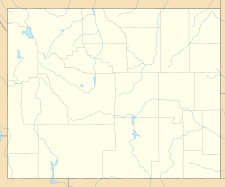Grasshopper Glacier (Wyoming) facts for kids
Quick facts for kids Grasshopper Glacier (Wyoming) |
|
|---|---|
| Type | Mountain glacier |
| Coordinates | 43°14′12″N 109°39′55″W / 43.23667°N 109.66528°W |
| Length | 1.3 mi (2.1 km) |
| Terminus | outflow stream/proglacial lake |
| Status | retreating |
Grasshopper Glacier is a cool glacier found in the Shoshone National Forest in Wyoming, USA. It sits on the east side of the Continental Divide, which is like a big ridge that separates rivers flowing to different oceans. This glacier is part of the Wind River Range and is one of many glaciers in the American Rocky Mountains.
The glacier flows towards the north. Its melting ice creates water for Grasshopper Creek. This creek eventually flows into the Wind River. Grasshopper Glacier also touches another glacier called Klondike Glacier to its south.
Contents
Why is it Called Grasshopper Glacier?
This glacier has a very interesting name! It's called Grasshopper Glacier because many grasshoppers have been found frozen inside its ice. It's like a natural time capsule for these insects.
The Big Flood of 2003
Between September 6 and 10, 2003, something big happened at Grasshopper Glacier. A large flood, called a glacial lake outburst flood (GLOF), occurred. This happens when a lake held back by a glacier suddenly breaks through.
What Caused the Flood?
At the top of Grasshopper Glacier, there was a lake called a proglacial lake. This lake was held in place by a natural ice dam. In 2003, this ice dam broke. Water from the lake then rushed out.
The rushing water carved a deep trench down the middle of the glacier. This trench was over half a mile (0.8 km) long.
How Much Water Was Released?
A huge amount of water was released during this flood. About 650 million gallons of water flowed out in just four days! This made the water level in Dinwoody Creek rise a lot.
The water flow in Dinwoody Creek went from about 200 cu ft (5.7×10−9 km3) per second to 900 cu ft (2.5×10−8 km3) per second. This was measured at a station about 17 mi (27 km) downstream.
What Happened After the Flood?
The powerful flood carried a lot of dirt and rocks with it. This debris was left behind more than 20 mi (32 km) downstream from the glacier.
Scientists believe this flood happened because the glacier has been shrinking quickly. Glaciers are said to be "retreating" when they get smaller. Grasshopper Glacier has been retreating ever since it was first measured accurately in the 1960s.


